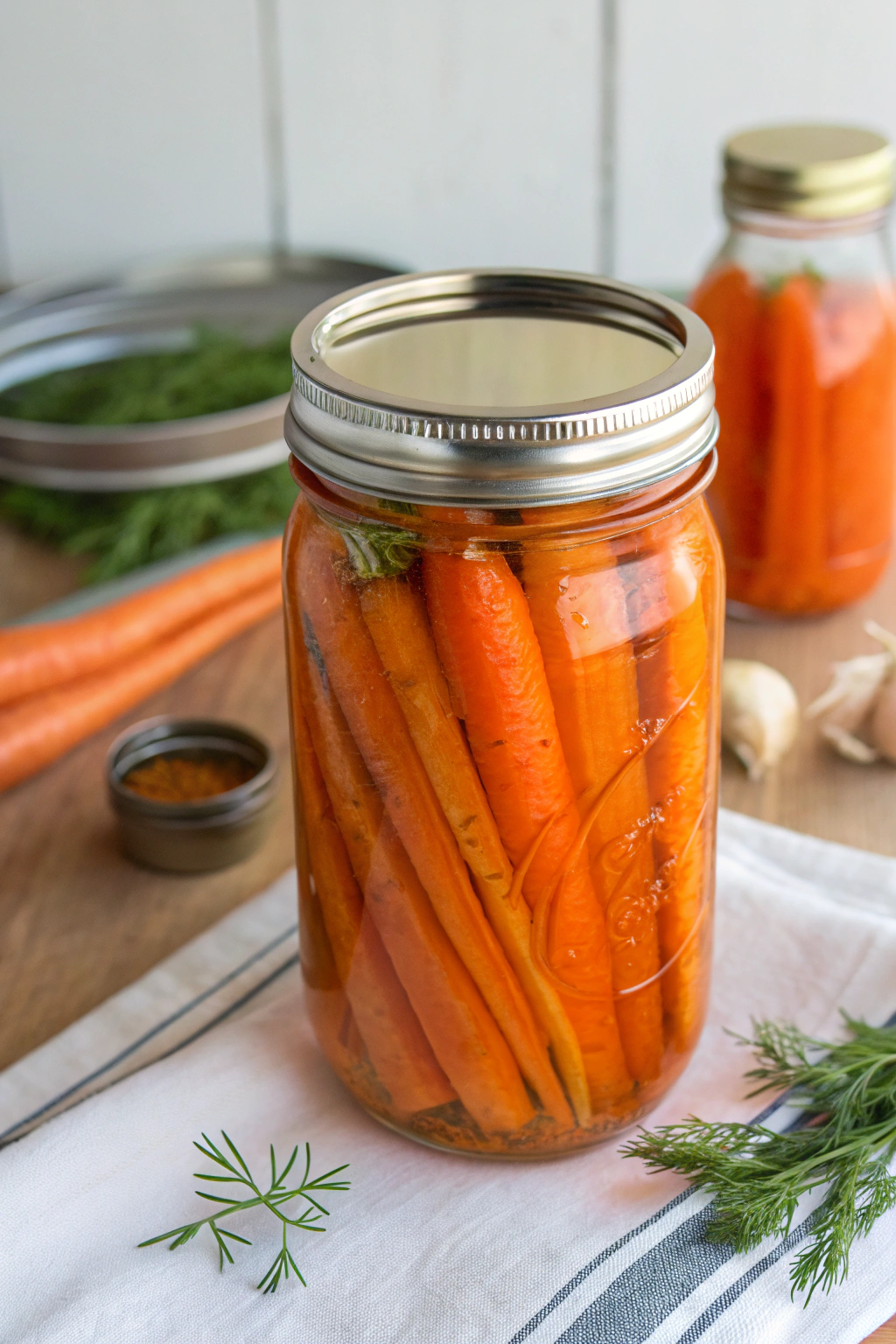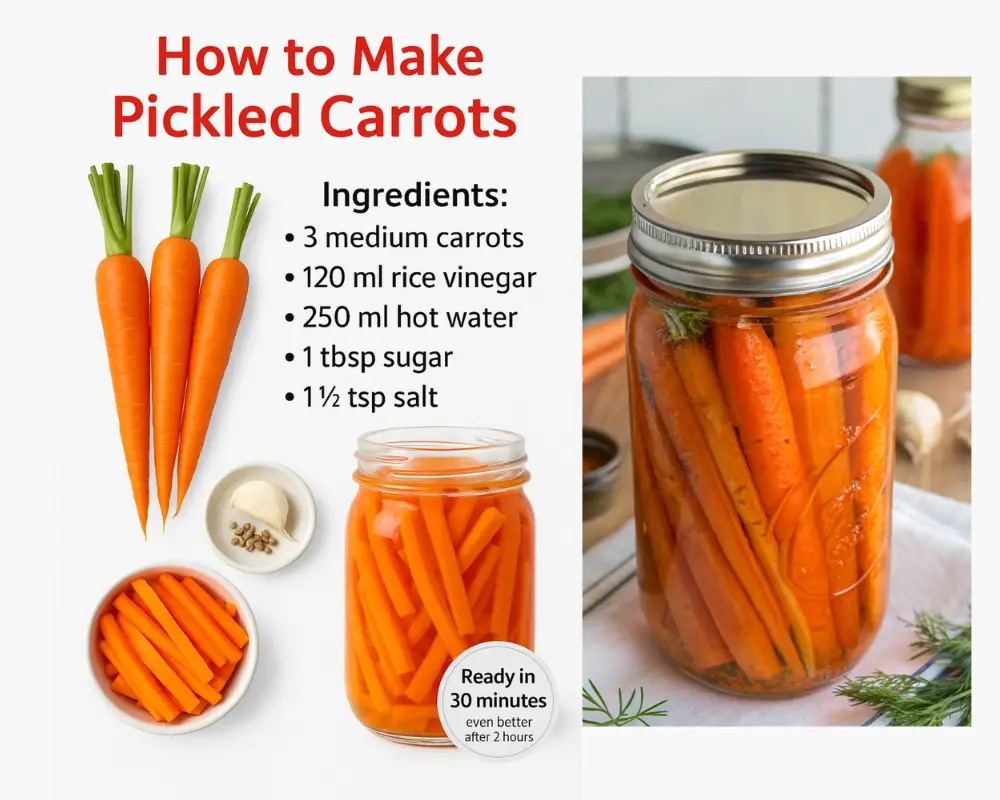How to Make Pickled Carrots at Home (Easy, Crunchy & Delicious)
How to Make Pickled Carrots at Home
Pickled carrots are one of the simplest and most flavorful homemade condiments you can prepare in just a few minutes. Crisp, tangy, and slightly sweet, they make a perfect snack on their own or a bright, refreshing addition to salads, sandwiches, tacos, rice bowls, grilled meats, and more.
Whether you’re new to pickling or already love making your own fermented foods, this guide will walk you through ingredients, step-by-step instructions, storage tips, flavor variations, and serving ideas. By the end, you’ll be able to customize your pickled carrots exactly to your taste.
Why You’ll Love Homemade Pickled Carrots
| Feature | Benefit |
|---|---|
| Fast preparation | Ready in as little as 30 minutes |
| Requires everyday ingredients | No special tools or rare spices needed |
| Affordable | Costs less than store-bought pickles |
| Customizable flavor | Adjust sweetness, acidity, and spices easily |
| Long storage life | Keeps well in the refrigerator for weeks |
Homemade pickles are also free of artificial preservatives and can be tailored to nutritional preferences such as low-sugar or low-sodium diets.
Ingredients You Need
Below is the ingredient list from the reference recipe:
| Ingredient | Amount | Notes |
|---|---|---|
| Carrots | 3 medium | Fresh, firm carrots are best |
| Rice vinegar | 120 ml | Mild vinegar gives smooth flavor |
| Hot water | 250 ml | Helps dissolve sugar and salt |
| Sugar | 1 tablespoon | Balances the acidity |
| Salt | 1½ teaspoon | Enhances flavor |
| Optional add-ins | Garlic, peppercorns, herbs | Use for flavor depth |
Why Rice Vinegar?
Rice vinegar is less sharp and acidic than distilled white vinegar, giving pickled carrots a cleaner, gentler taste.
However, you can substitute with:
| Vinegar Type | Flavor Level | Notes |
|---|---|---|
| White Vinegar | Strong | More sour, more pungent |
| Apple Cider Vinegar | Fruity | Adds a subtle apple aroma |
| White Wine Vinegar | Mild | Good for gourmet flavor |
Step-by-Step Instructions (Quick Pickling Method)

Step 1: Prepare the Carrots
- Wash carrots thoroughly.
- Peel if desired.
- Cut into matchstick-style sticks or thin rounds.
Tip: Uniform size = even pickling and best texture.
Step 2: Pack the Jar
Place the carrot pieces into a clean glass jar. Add optional spices such as:
- 1 clove garlic (sliced or whole)
- 5–10 peppercorns
- A pinch of chili flakes
- A sprig of fresh dill or thyme
Step 3: Make the Pickling Brine
In a heat-proof bowl, combine:
- 120 ml rice vinegar
- 250 ml hot water
- 1 tbsp sugar
- 1½ tsp salt
Stir until completely dissolved.
Step 4: Fill the Jar
Pour the hot brine over the carrots until fully covered.
Press gently to release trapped air bubbles.
Step 5: Let Them Pickle
- Leave the jar open for 5–10 minutes to cool.
- Seal with a lid.
- Chill in the refrigerator.
Ready in 30 minutes, but flavor improves significantly after 2–24 hours.
Flavor Variations to Try
| Flavor Profile | Add These Ingredients | Resulting Taste |
|---|---|---|
| Spicy | Chili flakes, sliced jalapeño, ginger | Heat-forward, vibrant |
| Sweet & Mild | Extra ½ tbsp sugar, a cinnamon stick | Softer and comforting |
| Herbaceous | Fresh dill, rosemary, thyme, bay leaf | Garden-fresh aroma |
| Asian-Inspired | Ginger slices, sesame seeds, garlic | Deep and savory |
| Mexican Style | Cumin seeds, oregano, chili peppers | Warm and earthy |
Experiment freely — pickling is very forgiving and open to creativity.
Storage and Shelf Life
| Storage Method | Shelf Life | Notes |
|---|---|---|
| Refrigerator (sealed jar) | 2–4 weeks | Keep carrots submerged in brine |
| Countertop (same day use) | Up to 12 hours | Only for short-term marination |
| Freezing | Not recommended | Texture becomes mushy |
Important Tips:
- Always use clean jars.
- Ensure carrots remain fully submerged to prevent spoilage.
- Never double-dip with used utensils (introduces bacteria).
Nutritional Benefits of Pickled Carrots
Carrots are naturally rich in:
- Vitamin A (for eyesight)
- Fiber (for digestion)
- Antioxidants (for general immunity support)
Pickling does not remove these nutrients.
| Nutrient | Function | Benefit |
|---|---|---|
| Beta-Carotene | Converts to Vitamin A | Supports eye and skin health |
| Fiber | Regulates digestion | Helps gut health |
| Potassium | Balances body fluids | Supports heart function |
| Vitamin K | Bone metabolism | Helps build strong bones |
Pickled carrots make eating healthy enjoyable and convenient.
Serving Ideas: How to Use Pickled Carrots
| Dish Type | How to Use Them |
|---|---|
| Sandwiches & Wraps | Adds crunch and a tangy contrast |
| Rice or Noodle Bowls | Balances rich and salty flavors |
| Salads | Boosts acidity and texture |
| Tacos & Burritos | Brings brightness and freshness |
| Charcuterie Boards | Pairs perfectly with cheese and cured meat |
| Snack | Enjoy straight from the jar |
They especially shine with:
- Grilled chicken
- Roasted vegetables
- Creamy sauces
- Spicy sauces
Troubleshooting Common Pickling Issues
| Problem | Cause | Solution |
|---|---|---|
| Carrots too soft | Boiling brine too long or cut too thin | Use thicker sticks; avoid cooking carrots |
| Brine too sour | Vinegar ratio too high | Add small amount of sugar or water |
| Not flavorful enough | Not enough time or spices | Let sit longer; increase seasoning |
| Cloudy liquid | Natural reaction of spices or minerals | Safe to eat if smell/taste is normal |
Frequently Asked Questions
1. Can I use baby carrots?
Yes. Cut them in halves or quarters for better absorption.
2. Can I reuse leftover brine?
Only if reheated and used for fresh vegetables, not eaten ones.
3. Do pickled carrots need to be canned?
Not for this quick-pickle recipe. Just keep refrigerated.
Printable Recipe Summary
| Step | Action |
|---|---|
| 1 | Wash and cut carrots |
| 2 | Place carrots in jar with optional spices |
| 3 | Mix vinegar, hot water, sugar, and salt |
| 4 | Pour brine over carrots |
| 5 | Chill and enjoy |
Final Thoughts
Making pickled carrots at home is quick, economical, and endlessly customizable. Whether you prefer spicy, sweet, tangy, or herbaceous flavors, you can create a jar that suits your taste perfectly. They store beautifully, enhance everyday meals, and support a healthy diet — all in just minutes of preparation.
If you start with this basic recipe and experiment a little, you may never want store-bought pickles again.


0 Comment